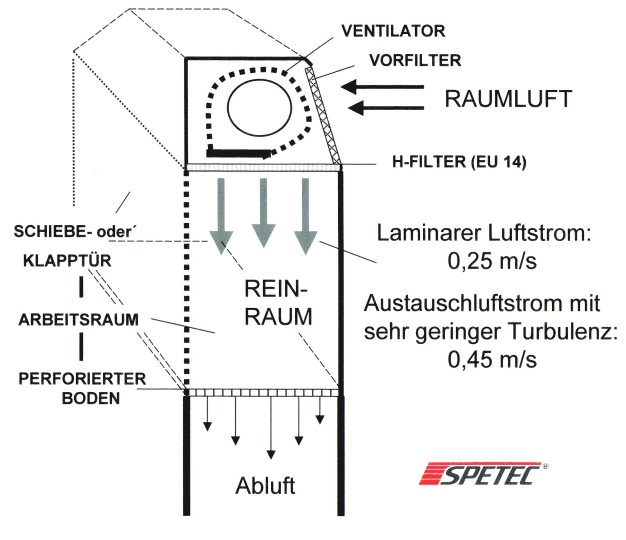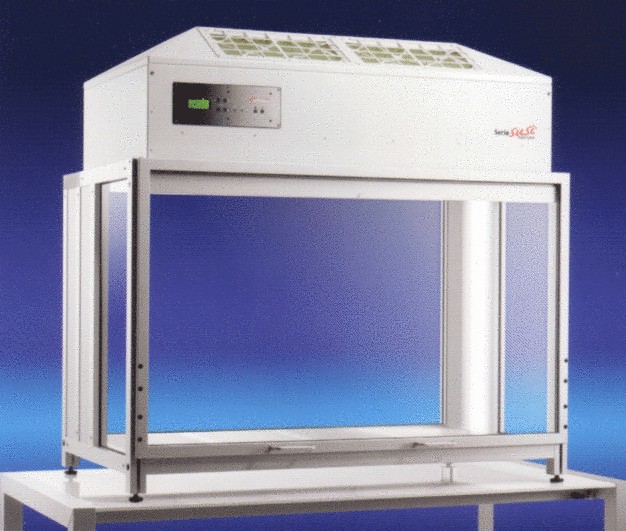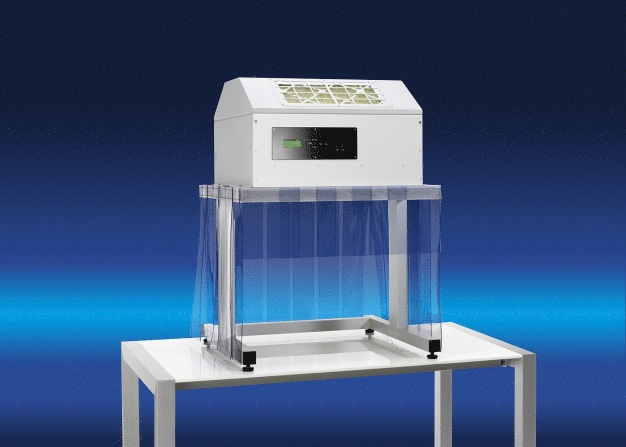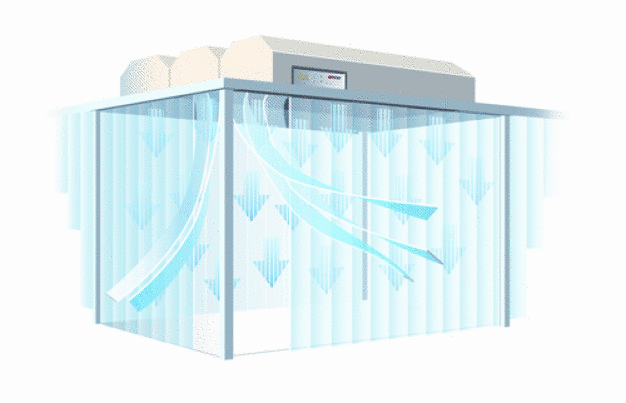- Planning
Prof. Knut Ohls
Variable size clean room cells for a particle-free working environment
For some 15 years now, Erding-based SPETEC Gesellschaft für Labor- und Reinraumtechnik mbH has been designing and building clean rooms of various sizes that allow flexible installation and which are tailored to meet the demands of the specific application and any particular customer needs. These products go under the name "Laminar Flow Box" and are familiar in a wide range of different sectors. They are used in industries such as electronics and optics, in packaging and in chemical analysis labs, in short, wherever it is necessary or recommended to carry out work in the cleanest possible atmosphere. Another field of application is the storage of equipment or substances that must not, under any circumstances, become contaminated.
The characteristic design feature is the combination of an enclosed space with a module equipped with a high-quality fan and a filter system made up of a pre-filter and a high-performance filter (EU 14). The filter classification EU 14 indicates that this filter is capable of filtering out 99.995 % of all particles with a diameter > 0.5 µm. The size of a module will depend on the content of the Flow Box. In the case of large clean rooms, known as clean room cells, it is also possible to use several modules in parallel. Today's modules are quiet in operation and feature a filter change indicator.
Two fundamentally different approaches are adopted for delimiting the clean room space: On the one hand, there is the almost fully enclosed space, known as the Laminar Flow Box, and on the other, there is the strip curtain, which allows objects behind the curtain to be picked up from the outside or equipment to be operated or, if the space is large enough, permits a person to actually enter the clean room, which remains flooded with pure air.
An enclosed clean room box (figure 1) has a robust design. Acrylic plastic or laminated glass sheets are fitted into the aluminum or stainless steel frame (figure 2). The frame is plastic-coated to permit handling of aggressive substances. SPETEC manufactures its products in compliance with GMP (good manufacturing practice) standards and is accredited accordingly. Alongside the standard sizes as listed in the company's catalog, a number of options are available, such as a storage box or a mobile clean room station, the Clean Boy (figure 3). In-house metalworking facilities allow custom sizes to be manufactured to meet specific customer needs. Walk-in clean room cells (Figure 4) are made from aluminum section or stainless steel. If the customer requires a GMP version, materials are used that have a surface roughness that is compliant with the GMP guidelines. Flush-fitting ceilings and side walls allow extremely easy, effective cleaning. And sharp corners and edges are always avoided for the same reason.
The use of profile systems allows customers to freely choose the dimensions of the clean room up to a size of 150 m². These clean room cells are an inexpensive alternative to complete clean rooms. As with complete clean rooms, these large clean room cells can also be equipped with pass-through hatches, material airlocks or access airlocks.
The characteristics and quality categories for clean rooms are laid down in the following standards: DIN EN ISO 14644, Part 1 (classes 1 – 9), DIN EN ISO 14698, Parts 1-3 and VDI 2083, Parts 1-18 (classes 0 – 7); US Federal Standard 209E (classes 1 – 100 000) or in the EC GMP Guidelines (classes A – D). The classes in this last document correspond to ISO classes 5 – 8.
Depending on the quality of the ambient air, filtering with the EU 14 filter can achieve a quality corresponding to ISO classes 5 – 8, i.e. one cubic meter of air contains one thousand to one million particles with a diameter of 1 µm. The isolation factor of the Laminar Flow Box is 10³. Thus, if this box were placed in a very good ISO class 6 complete clean room, a cubic meter of air would contain no more than 10 particles, which would be practically undetectable in the box.
The things that have the greatest impact on keeping objects clean are the ambient air and people. Clean rooms are also contaminated as a result of particles being transported through the air, the introduction of particles on technical surfaces and the production of particles by equipment, staff and running processes. In a class 8 clean room, more than 600 million particles (> 0.5 µm Ø) per cubic meter are given off per person per shift by the skin and clothing alone. This figure, along with other counts of particles of the same size given off when staff in protective clothing move (sitting with gentle movement of the lower arm: 20,000; standing up: 50,000 and slow walking: 80,000 per person) is based on data from the Fraunhofer Institute for Manufacturing Engineering and Automation (IPA) in Stuttgart. In addition to microdroplets, dust and smoke particles, the ambient air mainly contains bacteria (~ 0.5 – 50 µm Ø) and viruses (~ 0.005 – 0.1 µm Ø).
Another product in the SPETEC portfolio is the CleanBoy. The curtain bundles the laminar flow of clean air and largely prevents particles from entering from the sides.
Measurements have shown that even the unprotected flow of clean air generated by the module can reduce the number of particles, largely prevent particles from being disturbed by movement in the work area and deflect microdroplets, skin particles and clothing fibers away from the work area.
Both the Laminar Flow Box and the clean room station are available mounted on trolleys to allow objects and equipment to be moved between different rooms under clean-room conditions.
Depending on the application, SPETEC can also build and supply portable tabletop exhaust hoods or protective boxes for storing objects and equipment not required on a daily basis. Because we do not expect all customers to be immediately familiar with clean room technology, SPETEC also offers GMP-compliant support from planning and commissioning, right up to quality assurance.
The use of variable clean rooms to supplement expensive complete clean rooms or as an inexpensive alternative to them has led to the manufacture of ever larger clean room cells to house workbenches, food packaging machines, plastic production machines, filling systems for pharmaceutical products and other valuable apparatus and allow work to be carried out in a protected environment.
The SPETEC clean room system thus also allows special enclosures to be built (figure 4), with the frame made from aluminum or stainless steel section, the side walls from acrylic or laminated glass or stainless steel sheets and where the materials for the door elements, windows and tops can be freely selected. In the example shown, the modules provide a laminar flow of clean air. If equipment is housed in the enclosure, a low-turbulence flow of clean air is recommended to ensure as complete an exchange of air as possible. Enclosures such as these would be ideal for working in under particle-free conditions.
These few examples demonstrate how clean room technology and the resulting constructions have already become important tools in a variety of fields, and it is inevitable that other applications will follow.
![]()
Spetec Gesellschaft für Labor- und Reinraumtechnik mbH
Am Kletthamer Feld 15
85435 Erding
Germany
Phone: +49 8122 959090
Fax: +49 8122 9590955
email: info@spetec.de
Internet: https://www.spetec.de












